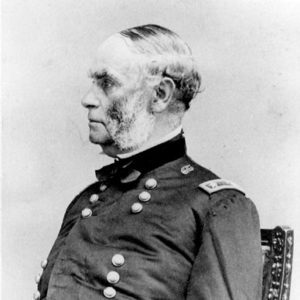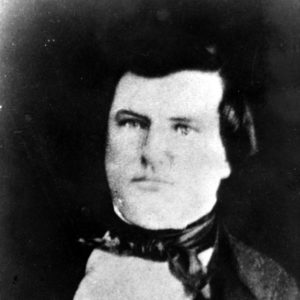calsfoundation@cals.org
Skirmish at Little Red River (May 17, 1862)
| Location: | Little Red River in White County |
| Principal Commanders: | Brigadier General Samuel R. Curtis (US); Brigadier General John S. Roane (CS) |
| Campaign: | Pea Ridge Campaign |
| Date: | May 17, 1862 |
| Forces Engaged: | Army of the Southwest (US); Army of the West (CS) |
| Estimated Casualties: | 1 (US); none (CS) |
| Result: | Confederate victory |
The Skirmish at Little Red River on May 17, 1862, was one of many that took place as foraging parties of Union major general Samuel R. Curtis searched for much needed provisions. On this rainy Saturday morning, about 100 Rebels, loosely organized but determined to thwart the Federals in their advance toward Little Rock (Pulaski County), attacked the foraging party sent by Colonel George E. Waring Jr. of the Fourth Missouri Cavalry. This skirmish—which took place two days before the most significant engagement in White County, the Action at Whitney’s Lane—coupled with skirmishes continuing into June, ultimately led to Curtis’s abandonment of his assignment to take the capital city and assume military authority over the state.
Following the Union victory at the Battle of Pea Ridge on March 6-7, 1862, Curtis moved a portion of his army to Batesville (Independence County), closer to supply lines and less than ninety miles north of Little Rock, where he would become military governor of the state and control the Arkansas River and its tributaries. After the defeat at Pea Ridge, Confederate general Earl Van Dorn was ordered to take his forces east of the Mississippi River to aid in the defense of Corinth, Mississippi. This left Arkansas without military leadership with field experience. Van Dorn left Brigadier General John Selden Roane in command, but he had no troops. Roane recruited the help of five regiments of Texas cavalry traveling through Arkansas on their way to Corinth, Mississippi, as he began to build an army.
In spite of the advantages of the Federal forces, the advance to the capital city was difficult. The flooded roadbeds, rough frontier, and meager crops resulting from heavy spring rains were major impediments to finding enough food to feed approximately 8,000 men and 1,000 horses and mules. Curtis wrote to Union brigadier general Scott Ketchum that “[I] started all the mills, and [am] grinding all the corn and wheat I can.”
The Little Red River runs through north-central Arkansas. It flows from Greers Ferry (Cleburne County) and merges with the White River east of the city of Searcy (White County). In a report to Curtis, Colonel Peter J. Osterhaus of the Seventeenth Missouri Cavalry described the river as “ a deep stream with clayish banks and no bridges or conveyances for crossing within twenty miles.” The skirmish of May 17 likely took place on the north side of the Little Red River, between Prospect Bluff—present-day Judsonia (White County)—and a point opposite West Point (White County). The ground upriver from West Point, for approximately two miles on the south side, is as much as sixty feet higher than the ground across the river on the north side. The firing likely began on the elevated side.
The details of the skirmish on May 17 come largely from a report written by Colonel George E. Waring Jr. of the Fourth Missouri Cavalry to Col. Osterhaus. Waring reported that a foraging party and an escort of thirty men was sent out to locate forage. They were attacked by about 100 Rebels firing from both the south and north banks of the Little Red River. This was about nine miles below the Federal camp near the community of West Point. The Rebels captured five wagons and twenty-four mules. Seven men were missing, supposedly killed. He said that he had sent a company of cavalry to reinforce the troops at Prospect Bluff and that a company of infantry was being sent at the time of writing the report. The Union foraging party was scattered and initially reported as all captured. However, all but one eventually returned.
Waring continued, “At West Point, 12 miles below our bridge, on the south side of the river, are two ferry boats. West Point is half as large as Searcy, and is the headquarters of this band of rebels. I have only 1 ½ companies of cavalry here in camp, and they are on duty or just off. Mr. Van Metre, who goes with the bearer of this, is apparently a Union man, or at all events, he gives us what information we have, and he also brought our foraging party safe into camp.” This “Union man” mentioned in this report was a local citizen. The exact role of this man—spy, informant, or double agent—is uncertain. Other sources have explored Mr. Van Metre and his actions in detail.
From the Confederate viewpoint, there is little, if any, primary source documentation of the May 17 skirmish. This absence of official reports reveals the condition of the Confederate army in Arkansas. Colonel John M. Harrell, writing in Confederate Military History, published in 1899, claimed that the Rebels in this attack served under a Captain Francis Marion Chrisman. A record of the events dated only as “May 1862” states that “men in Confederate Captain William Hicks’ Cavalry Company attacked a foraging party of the enemy on Little Red River, killing two, wounding several, and drove the enemy away.”
It is likely that Capt. Hicks’s men were involved in the May 17 skirmish; they were in the area and were involved in the Action at Whitney’s Lane two days later. Hicks was a lawyer and judge in Searcy. In February 1862, he had formed a cavalry company made up mostly of men from Searcy. Also in the area was Francis M. Chrisman, a Searcy landowner and key local figure listed as a lieutenant of the “Border Rangers,” a cavalry company formed in Searcy under Captain Dandridge McRae. Reports show that his men participated in the Whitney’s Lane action. However, Chrisman, also identified with the Independent Arkansas Cavalry, acted only as a guide for the Twelfth Texas Cavalry, under Major Emory Rogers.
Reflecting on the May 17 skirmish, William Burns of the Fourth Missouri Cavalry wrote in his journal, “Although the result was small, the affair was a warning, and the whole country was covered with brush, giving the rebels great advantage over us, we had now to anticipate ‘guerilla’ fighting.” Frequent skirmishes with the enemy such as the one on May 17, 1862, coupled with a lack of food and supplies, contributed to the abandonment of Curtis’s goal. Little Rock would remain under Confederate control until September 1863, more than a year later.
For additional information:
Akridge, Scott H., and Emmett E. Powers. A Severe and Bloody Fight: The Battle of Whitney’s Lane & Military Occupation of White County, Arkansas, May & June, 1862. Searcy, AR: White County Historical Museum, 1996.
Dennis, Frank, ed. Recollections of the 4th Missouri Cavalry: William S. Burns, Co I , 4th Missouri Cavalry (Union). Dayton, OH: Morningside House, 1988.
Dyer, Frederick H. A Compendium of the War of the Rebellion: Missouri Regimental Histories. New York: Yoseloff, 1900.
Evans, Clement A., ed. Confederate Military History: A Library of Confederate States History Written by Distinguished Men of the South. Atlanta, GA: Confederate Publishing Co., 1899.
The War of the Rebellion: A Compendium of the Official Records of the Union and Confederate Armies. Series I, vol. 13. Washington DC: Government Printing Office, 1885.
Loretta Haskell
White County Civil War Roundtable
 Civil War Timeline
Civil War Timeline ACWSC Logo
ACWSC Logo  Samuel Curtis
Samuel Curtis  John Roane
John Roane 




Comments
No comments on this entry yet.